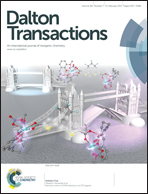Spin-glass behavior of a hierarchically-organized, hybrid microporous material, based on an extended framework of octanuclear iron-oxo units†
Abstract
Inspired by the stepwise addition of octanuclear iron units into mammalian ferritin, a “stop-and-go” synthesis strategy was used to prepare two microporous (Langmuir surface area, 490 m2 g−1; effective pore size, 4–5 Å) hierarchical materials {[Fe8(μ4-O)4(μ-pz)12Cl0.3(μ-O)1.85}n (1) and {[Fe8(μ4-O)4(μ-4-Me-pz)12Cl0.4(μ-O)1.8}n (2), which are new members of the EO2 family of polymeric materials (E = C, Si and Ge). The secondary building units (SBUs) E = [Fe8(μ4-O)4(μ-4-R-pz)12] (Fe8) are nanoscale pseudo-spherical clusters, rather than single atoms, forming μ-oxo Fe–O–Fe linkages between Fe8-SBUs. The characteristic Fe–O–Fe asymmetric stretching mode in the infrared (IR) spectra of these compounds appearing at around 800 cm−1 suggest the formation of approximately linear μ-oxo Fe–O–Fe linkages between Fe8-SBUs in 1 and 2. We employ the concept of continuous random network (CRN) to describe for the first time the framework features of a Fe8-based amorphous materials, in which the average connecting numbers of each Fe8-cluster are ∼3.7 and ∼3.6 for 1 and 2, respectively. 57Fe-Mössbauer spectroscopic analysis provides insights to the intercluster connectivity of 1 and 2 on one hand and to their magnetic properties on the other, evident by a magnetic split sextet below 30 K. The combination of Mössbauer spectroscopy and magnetism measurements reveals a spin-glass behavior with Tg of ∼30 K. The hierarchical porous materials 1 and 2 straddle the gap between metal oxides and metal–organic frameworks (MOFs). This study may open an alternative way for the development of multifunctional materials based on high nuclearity metal clusters.



 Please wait while we load your content...
Please wait while we load your content...